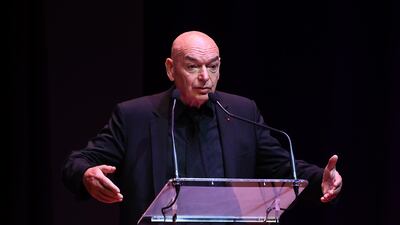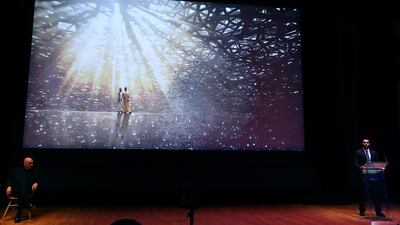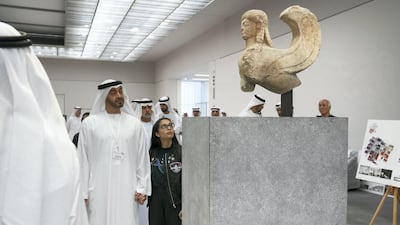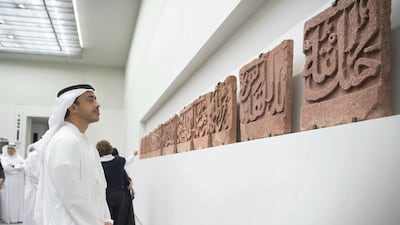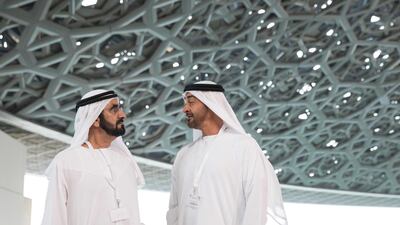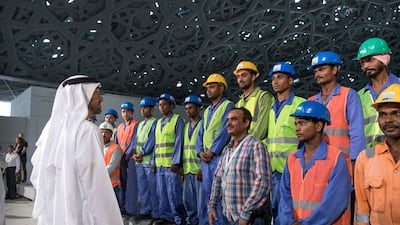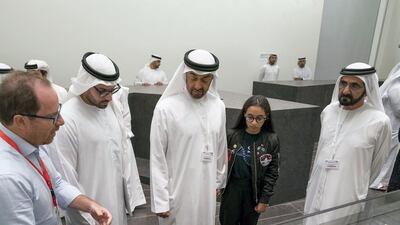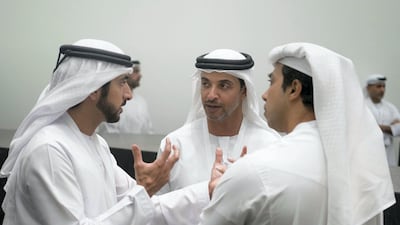It is a pity that the French minister of culture, Françoise Nyssen, was unable to make it to the Louvre Museum’s auditorium on Friday morning, because her speech contained a genuinely memorable quote.
The politician was delayed by the weekly cabinet meeting at the Elysee Presidential Palace, so one of her deputies stood in for her, reading the speech to the audience of journalists and museum professionals who had assembled to hear all about the opening of the Louvre Abu Dhabi.
As well as looking forward to the Saadiyat Island museum’s unveiling, Nyssen also looked back to a post-revolutionary moment just prior to the opening of the original Musée du Louvre in 1793 and to a letter written to the painter, Jacques Louis David, by a French minister of the time.
“This museum must nurture a taste for the fine arts, it must entertain art lovers and it must teach artists, it must be open to everyone, to the whole world, no individual should be deprived of it. It shall be instrumental in shaping the finest knowledge, and it should spark the admiration of the universe.”
As Nyssen’s speech noted, two centuries later, the quote applies to the Louvre Abu Dhabi equally well, a museum that will not only contain works by Jacques Louis David – his portrait, Napoleon Crossing the Alps (1802) will be on loan from the Palace of Versailles – but which also aims to be a very different kind of institution for the 21st century.
The scientific director of Agence France-Muséums and curatorial driving force behind the new museum, Jean François-Charnier, outlined how the Louvre Abu Dhabi aimed to be unique and different, not just from the 13 French museums that will be providing it with loans, but globally.
“We want to chart the path that humankind has followed with a sense of consistency” said the curator, who the day before had been busy at the Louvre Abu Dhabi installing the Apollo Belvedere statue by Francesco Primaticcio, Le Primatice (1504–1570), which is on loan from the Palace of Fontainebleau.
“What is the meaning of the word universal in a multi-polar, multicultural world,” Charnier asked, referring to the phrase that was included in the original inter-governmental agreement between the UAE and France that was signed in March 2007.
“The phrase originates in the era of the [European] Enlightenment, but in Abu Dhabi it has a different meaning,” the curator suggested, stating that after two centuries of colonialism, de-colonisation and post-colonialism, the museum was obliged to re-think the notion of universalism for the 21st century in a way that breaks down barriers between cultures and emphasises moments of connection.
“We want to allow visitors to see the communication between civilisations over time and this gives the museum a narrative that is chrono-thematic with 12 key steps, each one of which represents a key moment in the history of humankind,” he added.
“We also want a shift in focus. This museum is designed and built in Abu Dhabi, not Paris, so other continents – the Indian sub-continent, Asia, China – all of these had to be considered,” Charnier insisted.
“We are not talking about the Middle Ages or the Renaissance in Abu Dhabi because they are essentially European phenomena that are of no concern to the whole world, but in a few weeks’ time, visitors to the Louvre Abu Dhabi will see a kind of summation of the whole history of humankind that focuses on what is common in humanity.”
____________
Read more:
Making A Masterpiece: The inside story of the Louvre Abu Dhabi
Louvre Abu Dhabi: some of the world's most famous artworks will be on loan
Visit Louvre Abu Dhabi to explore fresh dialogue, art history
____________
Charnier was speaking as part of a seven-person panel that included the chairman of Abu Dhabi’s Department of Culture and Tourism, Mohamed Khalifa Al Mubarak, the Louvre Abu Dhabi’s director Manuel Rabaté, its designer, Jean Nouvel, the President-Director of the Louvre Museum, Jean-Luc Martinez and Marc Ladreit de Lacharrière, the chairman of Agence France-Muséums, the body charged with providing the technical expertise to deliver the new museum.
More lecture than press conference, the presentation allowed no time for questions from the press, prompting complaints that it revealed little about the Louvre Abu Dhabi that wasn’t already known, but the speeches actually contained interesting references to its origins that had not been shared before in public.
The Louvre Abu Dhabi’s architect, Jean Nouvel, made reference to the early but crucial role played by the former director of the Solomon R Guggenheim Foundation in New York City, Thomas Krens, in not only bringing him on board in late 2006, but in suggesting that Venice metaphor that the architect eventually adopted for the museum.
Krens was widely credited at the time with having launched a new museum phenomenon, the 'Bilbao effect', thanks to the success of the Guggenheim Museum Bilbao, which he launched in 1997, an event that was not only credited with reversing the fortunes of the ailing Spanish city, but also with heralding a new museum-building era.
“The idea was to build a cultural neighbourhood with five top-notch facilities,” Nouvel explained. “All this facing Abu Dhabi on the island of Saadiyat, on a stretch 2 kilometres-long. The ambition was totally mind-boggling, and as soon as I made my submission, it became an obsession.”
“I tried to design what a museum of civilisation could be,” the 72-year-old architect continued.
“I looked at what was on the site in the first place. There was sand, there was water, and there was the sky and a perception of a horizon with the city on one side and the sea on the other,” said Nouvel, who is currently working on major museum projects in Abu Dhabi, Qatar and China.
“I figured that a museum had to be a meeting place, a venue where people come, come again and where everyone feels comfortable expressing themselves and where the works are accommodated in an exceptional way,” Nouvel explained.
“Geometry and light prevail in Arab architecture, so along with the [museum’s dome] I wanted to create a sense of belonging with the sky and the geometric interplay with the rain of light,” he added.
“There is this thermal micro-climate that ensues, where the temperature is cut by 3,4 or 5 degrees and with the sea breeze this is a place where one can walk as if one were walking beneath a tree. That is the museum that was suggested, designed and built.”
Whether Nouvel has achieved the metaphysical serenity he is searching for and just what Charnier’s new vision of universalism looks like, will finally be revealed to the public in just seven weeks’ time. Tickets are already on sale for the Saadiyat Island museum, which will open to the public on November 11.

